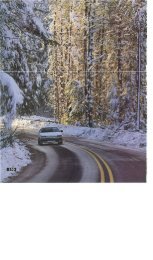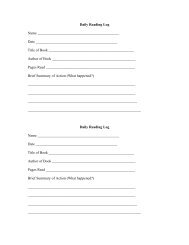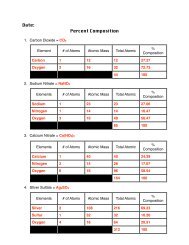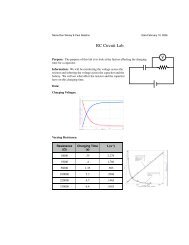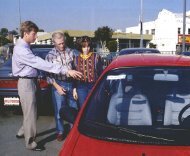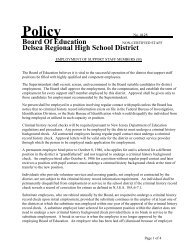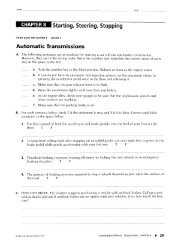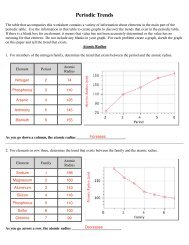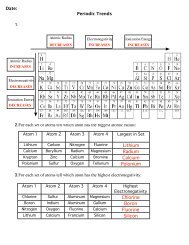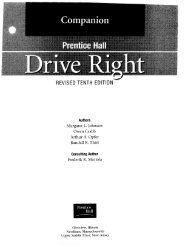LAB #9: WHEN PIGS FLY 11/28/07 - Delsea
LAB #9: WHEN PIGS FLY 11/28/07 - Delsea
LAB #9: WHEN PIGS FLY 11/28/07 - Delsea
- No tags were found...
You also want an ePaper? Increase the reach of your titles
YUMPU automatically turns print PDFs into web optimized ePapers that Google loves.
<strong>LAB</strong> <strong>#9</strong>: <strong>WHEN</strong> <strong>PIGS</strong> <strong>FLY</strong><strong>11</strong>/<strong>28</strong>/<strong>07</strong>JESSE BUTCHJOE DIGREGORIOPURPOSEThe purpose of this lab is to find the relationship between length of a string and frequency,angle, speed and radius for a suspended object moving in a horizontal circle (self-propelledtorsion pendulum).INFORMATION-Hang an object (self-propelled) from the ceiling with a piece of string (make it as close tothe floor as possible)--Measure the length of the string-- Mark the center of the circle by suspending the object motionless-Turn on the power to the object and then give the object a light thrust to begin its circularmotion.--Mark a point on the floor where the object reaches in its flight. Measure from thecenter point to this point on the floor (radius).--Count the number of rpm (frequency) of the object.--Determine the angle of the string (angle) by taking the arcsine of the radius/length.-Calculate the speed of the object using the circular velocity formula, v=(rpm*2*pi*r)/60-Repeat this process for 5 trials total.
HYPOTHESIS1. As the length increases, the frequency of the object will decrease, resulting in a linearrelationship2. As the length increases, the radius of the object will remain the same, resulting in norelationship3. As the length increases, the angle of the object will decrease, resulting in an inverserelationship4. As the length increases, the speed of the object will decrease, resulting in an inversesquared relationshipDATALENGTH (m)FREQUENCY(rpm)RADIUS (m) ANGLE (º) SPEED (m/s)2.53 19.8 1.13 26.5203 2.3432.18 21.7 1.04 29.4838 2.3631.73 24.5 .98 34.5047 2.5141.215 30.1 .635 31.5091 2.002.85 37.6 .635 48.3362 2.500GRAPHSFREQUENCY (rpm) VS. LENGTH (m) FOR A SELF-PROPELLEDTORSION PENDULUM
RADIUS (m) VS. LENGTH (m) FOR A SELF-PROPELLED TORSIONPENDULUM
ANGLE (º) VS. LENGTH (m) FOR A SELF-PROPELLED TORSIONPENDULUMSPEED (m/s) VS. LENGTH (m) FOR A SELF-PROPELLED TORSIONPENDULUM
CONCLUSIONThe purpose of this lab was to find the relationship between length of a string andfrequency, radius, angle, and speed of a suspended object moving in a horizontal circle(self-propelled torsion pendulum). The materials for this lab include: one battery operatedflying object, string, tape, and a meter stick. To begin the lab, we tied a piece of string tothe ceiling and then to the battery operated flying object to suspend the object. Next, wemarked off a point on the floor with tape where the center of the circle the object wouldcreate would be, which is right under the object when it remains motionless. After that, webegan to collect data by thrusting the object into a circular path and then waited until theforce we applied to it became negligible and its self-propulsion took over. While it wascompleting its revolutions, we marked off a point on the floor with tape where the objectflew over, giving us the radius of the horizontal circular path. With radius and string length,we found the angle of the string by taking the arcsine of radius/length. After doing this, webegan to count the revolutions per minute of the object. With all of this informationgathered, we could determine the linear velocity of the object, its speed in m/s, by applyingthe velocity of an object in a circle formula, v=(rpm*2*pi*r)/60. We repeated this process4 more times to have 5 trials of data gathered for 5 different lengths of string. To expressour data, we created 4 separate graphs, "Frequency (rpm) vs. Length (m) for aSelf-Propelled Torsion Pendulum", "Radius (m) vs. Length (m) for a Self-Propelled Torsion
Pendulum", "Angle (º) vs. Length (m) for a Self-Propelled Torsion Pendulum", and "Speed(m/s) vs. Length (m) for a Self-Propelled Torsion Pendulum".Our first graph, "Frequency (rpm) vs. Length (m) for a Self-Propelled Torsion Pendulum",like all of our graphs, had scattered points making it impossible for us to curve fit the graphto get values to determine a mathematical relationship, and it was also impossible to curvefit because of the complex trigonometric relationships that Logger Pro didn't contain. Theoverall trend of the first graph tells us that as length increases, frequency decreases. Thefirst graph partially verified our hypothesis that as the length increases, the frequencydecreases, it only nullified our graph relationship prediction of a linear relationship. Ournext graph, "Radius (m) vs. Length (m) for a Self-Propelled Torsion Pendulum", had anoverall trend that displayed an increase in radius as length increased. This relationship,juxtaposed with the frequency vs. length relationship, make the object appear to travel thecircle at a faster speed as the length of the string shortens. Our hypothesis was completelynullified because we said that length would have no affect on radius, resulting in norelationship. The following graph, "Angle (º) vs. Length (m) for a Self-Propelled TorsionPendulum", demonstrated an overall decrease in angle as length increased. Our hypothesiswas partially verified in that we had the general trend correct when we stated that as lengthincreases, angle decreases, but we stated that it would have an inverse relationship which itdid not. Our final graph, "Speed (m/s) vs. Length (m) for a Self-Propelled TorsionPendulum", showed a general slight decrease in speed as length increased. This againpartially verified our hypothesis for the part where it stated as length increases, speeddecreases, but we failed to get the correct relationship, stating it would be inverse squared.The final graph failed to accurately represent the true relationship of speed vs. lengthbecause of one main source of error, battery operation. The true relationship should havebeen no relationship, showing that as length increases, speed remains constant. Becauseour object had a gradually depleting energy supply, it failed to keep a constant speed.Battery operation can also be held accountable for the error points on the 3 other graphs,making it impossible to curve fit any of them. Any other error would be negligible in thepresence of tis main error, therefore, this is the only error in this lab.




